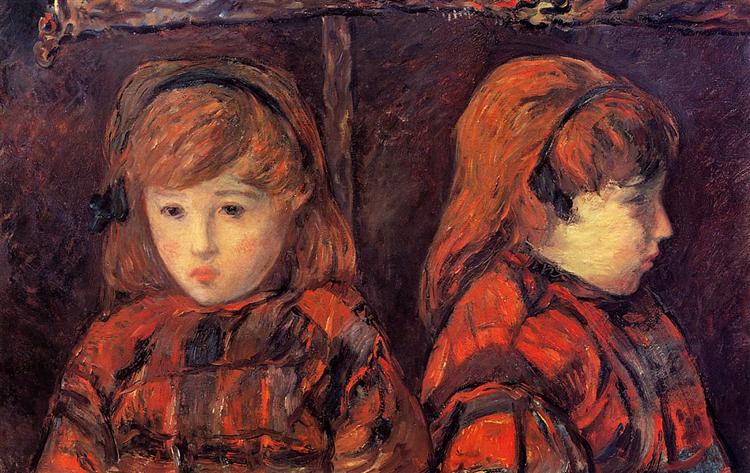Description
In the 1883 work "Double Portrait of a Young Girl (Mademoiselle Lafuite)", Paul Gauguin offers a fascinating exploration of youth and innocence through the depiction of two young figures. Reflecting Gauguin's innovative approach to portraiture, the painting combines elements of symbolism and post-impressionist aesthetics, bridging visual reality with emotionality through compositional choices and a distinctive color palette.
The composition focuses on two young women who, although presented simultaneously, seem to be bathed in an aura of individuality. While both are positioned on a similar plane, the artist employs a masterful use of color and light to shape their unique features. On the left, a young woman observes with a serene expression, her face illuminated by a light that suggests presence and contemplation. Her clothing is a light tone that accentuates her delicacy and softness, while establishing a subtle contrast with the background.
In contrast, the figure on the right is presented in a darker colour scheme and a background that heightens her mystery. The combination of these elements not only highlights the individuality of each of the young women, but also raises questions about their relationship. Gauguin plays with the notion of duality, suggesting an implicit interaction between the two figures that transcends mere physical representation. Their hands seem to communicate visually, further suggesting an emotional bond that invites the viewer to reflect on the nature of friendship and connection.
The coloristic aspect of the painting is equally intriguing. Gauguin uses a rich and saturated palette, where yellows, blues and pinks not only serve a representational function, but communicate sensations. The choice of these colors can be interpreted as a means of expressing moods and feelings, using color theory in an intuitive and evocative way. This coloristic strategy recalls the characteristics of symbolism, where color is not limited to describing the natural sphere, but seeks to delve deeper into the emotional and psychological aspects of human experience.
In looking at "Mademoiselle Lafuite," one can see Gauguin's transition between Impressionism and what would later be defined as his own distinctive style. In this work, the simplification of forms and bold use of color anticipate his evolution toward symbolism and the application of the concept of "primitivism," which would dominate many of his later works. The work, though still in a relatively realistic context for Gauguin, already signals his intention to move beyond objective representation toward a search for inner meaning and emotional evocation.
Although the historical context of the work may seem complex, it is essential to recognise that it was created during a period when Gauguin was absorbing influences from various artistic movements and cultures. The painting is set in a time when modernity was beginning to flourish, and artists like Gauguin were driven to explore the unknown, challenging accepted norms of representation.
The work “Double Portrait of a Young Girl” not only stands as an excellent example of Gauguin’s talent for using color and form, but also captures the soul of a moment, a fleeting youth, and the weight of human relationships encapsulated in a visual instant. This painting is, without a doubt, a tribute to the beauty of the everyday and the complexities of youth, a theme that resonates across generations and continues to inspire artists and critics today.
KUADROS ©, a famous painting on your wall.
Hand-made oil painting reproductions, with the quality of professional artists and the distinctive seal of KUADROS ©.
Painting reproduction service with satisfaction guarantee. If you are not completely satisfied with the replica of your painting, we will refund 100% of your money.

